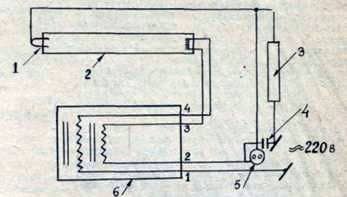
1 – burnt end of the lamp; 2 – lamp LDC-40 W; 3 – resistance R, 470 K; 4-capacitor C1 3.8 μf x 400 V;
5- starter SK 220 (15-80); 6 – throttle 1 хве 80/220
Developed a scheme that makes it possible to operate daylight lamps that have worked their time (burnt out) with the traditional connection scheme. The essence of my scheme is that this kind of lamp, as a rule, burns out only one thread of heating. On the other side of the lamp, the thread remains intact. It is this circumstance that I used (see the diagram).
The ends of the thread, which is burned out, are short-circuited. The circuit uses a standard choke from a luminaire designed for a 80W lamp, a universal starter, an oil-filled capacitor of 3.8 muf. You can also use a homemade puller, wound with a PEL wire with a diameter of 0.3-0.5 mm. Resistance of inductively coupled coils at a constant current of approximately 4 ohms each. If there is no oil-filled condenser, any nonpolar one, for example, of MBGO type with a capacity of 4 μf И ¶60ч, is suitable.
As practice showed, they keep the voltage of the network well. The capacitance of the capacitor near the starter in the circuit is not indicated, since it is determined by the type of the latter. Lamp for 40 watts select such that the burnt end is not smoked, and also without mechanical damages. The power of the lamp connected in this way decreases by 30 percent. Nevertheless, it gives quite enough light, say, for a greenhouse or a stable. Serves as much as the new one.
Мед для печени и желчного. Рыжая пчела.
Useful tips for the amateur beekeeper